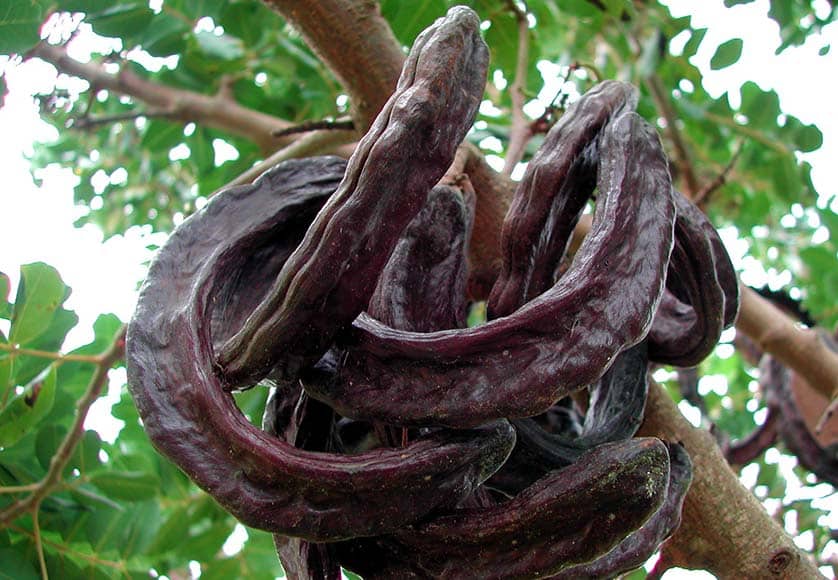We are in the middle of the carob season here in the Algarve. This year it has a particular frenzy to it as the price being paid for these shiny black beans has gone through the roof.
We live on land designated as a carob farm (cultura alfarrobense), so we have collected the beans for the last 18 years. Our first year (2004), we received the princely sum of €3 per 15kg – this season that has already risen to over €40. No wonder the GNR are kept busy trying to stop the inevitable theft of full sacks from local growers.
Carobs provide a natural, plant-based, vegan food thickener used in many commercial products, and the current interest in plant-based diets has increased demand … and the price.
The story of this productive, drought-tolerant and very special tree is an amazing mix of speculation coupled with scientific investigation.
The location of the wild ancestors is still controversial. At one extreme are those who point to the so-called Oleo-Ceratonion assemblage of plants used in vegetation classification and who, therefore, argue that the original range was the whole Mediterranean basin; at the other extreme are those who argue that their homeland was a much more restricted zone, the highlands of southern Arabia. In support of this, the trees suffer severely in cold winters, even when they grow close to the sea, and they flower in the autumn, like many tropical plants.
It is also not agreed whether the carob-tree was domesticated in the Middle East or in Arabia and the Horn of Africa. However, the present distribution of the carob-tree is not disputed. It is found throughout the coastal regions of the Mediterranean. The tree’s domestication is a great example of human selection of the best varieties and forms.

In 2018, 60% of global production came from Portugal, Italy and Spain, with Portugal by far the largest producer at 43,000 tonnes. Interestingly, Switzerland ($9.9M) constitutes the largest market for imported carob worldwide, comprising 34% of global imports – maybe there is something more in all that chocolate!
It is known that the genus Ceratonia formed part of the wild flora of western Europe in preglacial times, that C. siliqua was present in ancient times in the Middle East and that its spread to the western Mediterranean area took place progressively, possibly beginning in the second millennium BC. There is only one other species – Ceratonia oreothauma from Oman and Somalia. Except in the case of Greece and southern Italy, most of the names applied to the tree today in European languages are linked to Arabic, inferring that today’s cultivars were probably selected by Muslims in the Middle Ages.
Currently, there are many varietal forms in cultivation, and the current economic interest should safeguard this precious genetic resource. In 1900, 17 varieties were documented in the Algarve and the most productive trees are the result of careful grafting onto root stocks.
Algarve varietal forms include mulata, galhosa and the less common canela. The carob is integrated into the famous ‘dry orchard’ agriculture system (pomar de sequeiro) together with almond, olive and fig. The carob also has huge potential as a carbon sink, requiring little maintenance, long lived and drought tolerant. The largest carob tree in Portugal is near to Moncarapacho, estimated to be over 600 years old and still producing huge quantities of beans.
The increasing demand on the world market for carob gum (locust bean gum, LBG) is lending new importance to the crop. LBG is processed from the seeds and used as a stabilizer in foods and medicines. The seed pods of the tree are separated into pulp and seed, and the gum is derived from the split, milled seeds, while carob powder, with a naturally sweet chocolate flavour, is produced from the pods.
Used as a thickening and gelling agent in food production, it is commonly found in salad dressings, sauces, meat products, breads, and breakfast cereals as well as dairy products.
If you are lucky enough to have this tree in your garden, you are directly connected to the ancient history of the mediterranean region.
Rosie Peddle – mgapsec@gmail.com
Professional Association for Carob Growers – https://aidalfarroba.wixsite.com/aida
By Rosie Peddle
|| features@algarveresident.com
289 791 869 | mgapsec@gmail.com
facebook.com/MedGardenersPortugal
www.mgaportugal.org




















